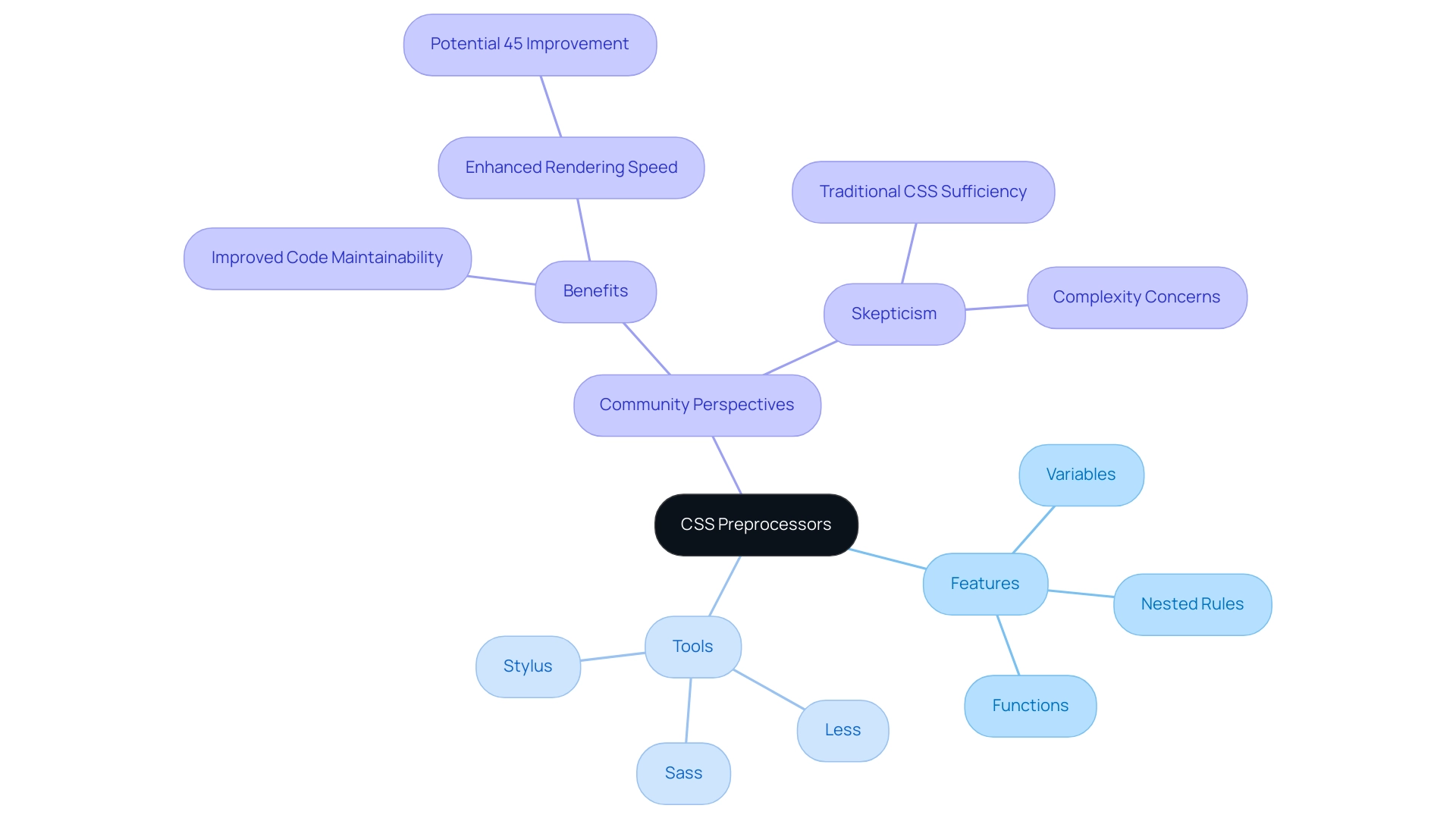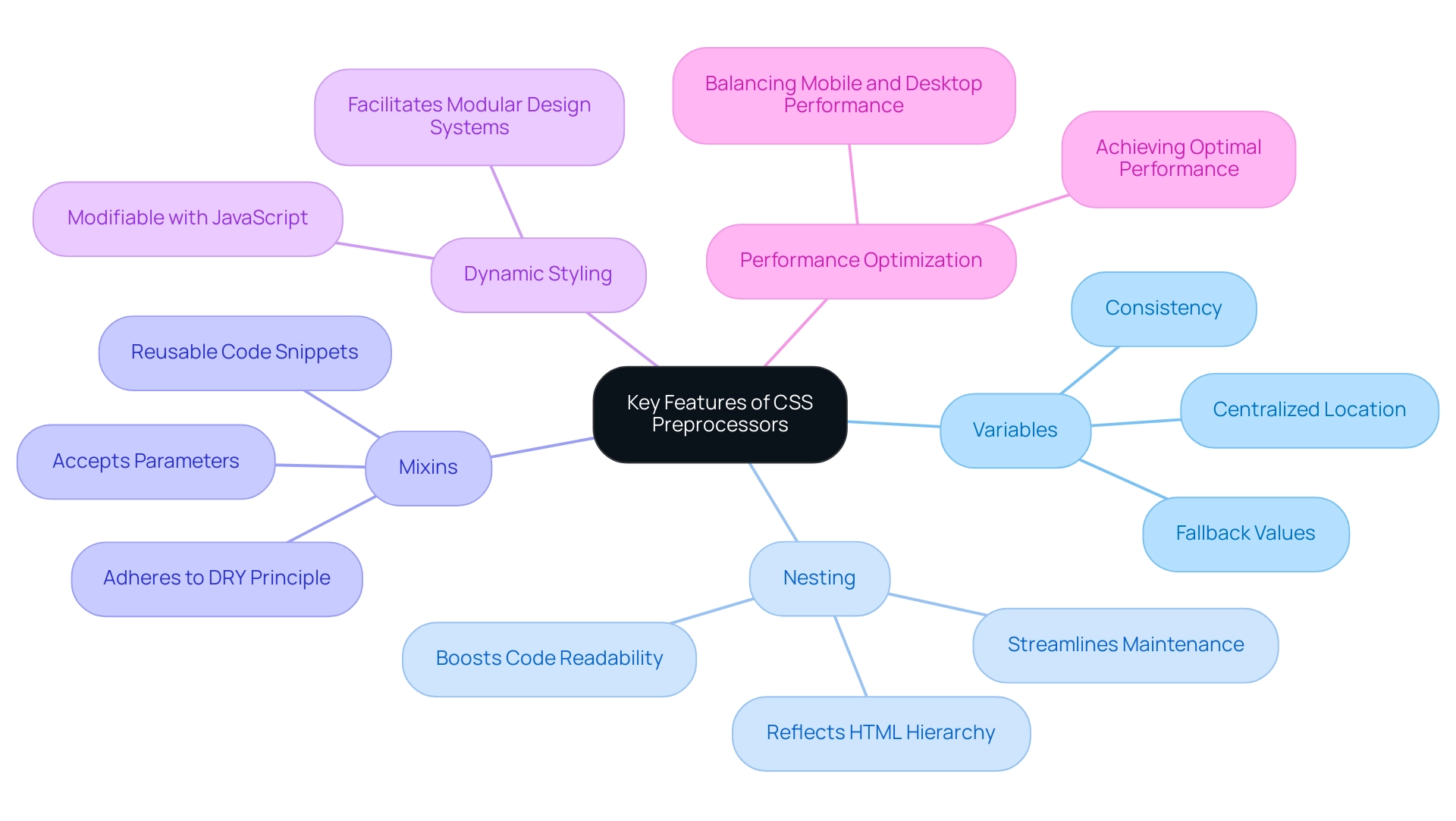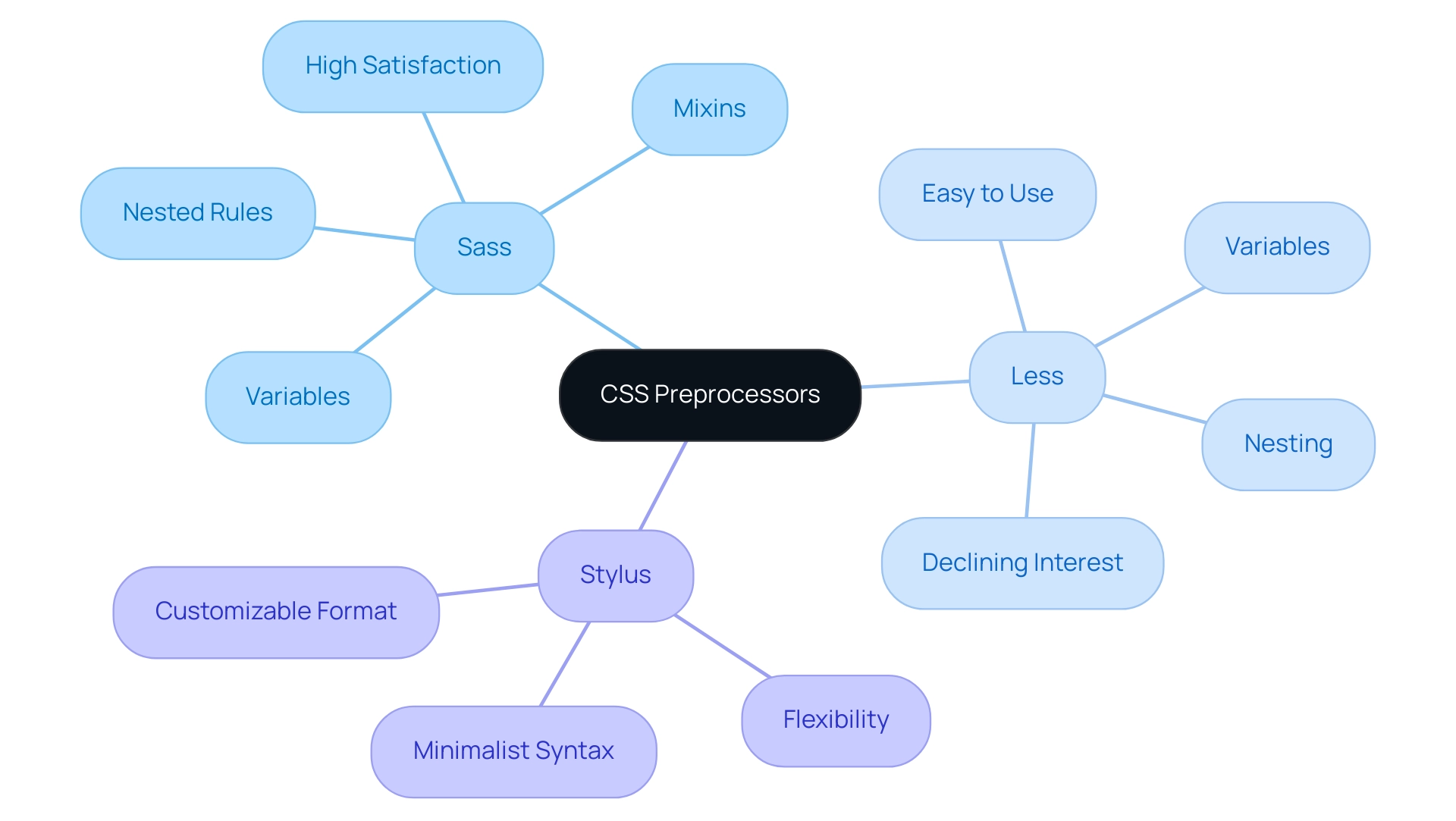Introduction
In the ever-evolving realm of web development, the quest for efficiency and productivity remains paramount. CSS preprocessors have emerged as transformative tools, empowering developers to write cleaner, more manageable code while enhancing the overall styling process.
With features like variables, nesting, and mixins, these advanced scripting languages not only streamline workflows but also address the complexities of modern web projects.
As developers increasingly recognize the need for ongoing education and adaptation to new technologies, the debate around the necessity and benefits of preprocessors intensifies.
This article delves into the intricacies of CSS preprocessors, exploring their key features, advantages, challenges, and the leading options available today, ultimately revealing how they can elevate web development to new heights.
Defining CSS Preprocessors: An Introduction
To understand what are CSS preprocessors, it's important to note that they are advanced scripting languages designed to enhance the capabilities of traditional CSS (Cascading Style Sheets), enabling developers to write code in a more dynamic, efficient manner. These tools introduce powerful features such as:
- Variables
- Nested rules
- Functions
These features significantly streamline the styling process and improve code maintainability. As they compile into standard CSS, they facilitate a more organized workflow, especially in large-scale projects.
Sass, Less, and Stylus are well-liked tools that exemplify what are CSS preprocessors, each offering distinct features and syntax choices to address diverse programming requirements. With a growing emphasis on ongoing education in modern CSS, as noted in the 2024 Learning Resources Report, which states, "Success with modern CSS requires ongoing education and skill development," professionals are increasingly recognizing the value of these tools.
Significantly, intricate CSS coding can hinder rendering by 35%, but by simplifying specificity patterns using tools, programmers can potentially enhance rendering speed by up to 45%.
However, it is worth mentioning that some programmers express skepticism about the need for tools that process code beforehand, arguing that traditional CSS can suffice for smaller projects without the added complexity. This emphasizes a gap in the programming community concerning what are CSS preprocessors, as some advocate for their application in larger projects to achieve improved code management.
Overall, the capability to streamline intricate CSS coding guarantees a more manageable method for stylesheet creation, positioning tools as invaluable assets in modern web design.

Key Features of CSS Preprocessors: Variables, Nesting, and Mixins
The key features of CSS preprocessors drive enhanced efficiency and maintainability in web development:
- Variables: By enabling developers to store values such as colors, fonts, or spacing in a centralized location, variables promote consistency across stylesheets. This simplifies updates, ensuring that any adjustments can be made swiftly and uniformly. Notably, fallback values are especially useful when using CSS variables in environments where support might be limited, ensuring a graceful degradation of styles.
- Nesting: This functionality enables programmers to structure CSS selectors in a way that reflects the HTML hierarchy. Such organization not only boosts code readability but also streamlines maintenance, making it easier to navigate through complex stylesheets.
- Mixins: Mixins facilitate the inclusion of reusable code snippets that can accept parameters, adhering to the DRY (Don’t Repeat Yourself) principle. This reduces redundancy in stylesheets, ultimately leading to cleaner and more efficient code management.
As Neha Udeshi, a Software Engineer at ServiceNow, notes, "CSS variables can be modified dynamically using JavaScript," further illustrating their versatility in modern web development.
Utilizing these features enables creators to produce highly efficient stylesheets, which can be understood as what are css preprocessors that are not only easier to manage but also adaptable to the evolving needs of web projects. For instance, a case study on balancing mobile and desktop performance highlights how creators utilize CSS extensions to achieve optimal performance across both platforms. As the landscape of web creation continues to advance, the importance of these functionalities cannot be overstated.

Advantages of Using CSS Preprocessors in Web Development
The benefits of using CSS tools in web creation are significant and can greatly improve project results:
- Improved Maintainability: By incorporating features such as variables and mixins, developers can streamline the process of maintaining and updating styles. This decreases errors and encourages the DRY (Don’t Repeat Yourself) principle, which is essential in reducing redundancy and improving code clarity.
- Improved Organization: The capacity to nest styles leads to a clearer and more organized codebase, aiding better team collaboration and understanding of each team member's contributions.
- Faster Progress: CSS tools can significantly reduce creation time by minimizing repetitive code and permitting quicker adjustments, enabling teams to deliver projects more efficiently. However, it's important to note that tools like Less are a good example of what are css preprocessors, which may have performance overheads due to their compilation process and could affect overall efficiency compared to other options.
- Better Collaboration: With a standardized styling approach, teams can work more cohesively, leading to smoother workflows and fewer code merging conflicts. Riot Games, the famous company behind League of Legends, has successfully implemented Stylus in various projects, stating that it has significantly enhanced their production processes. This demonstrates how industry leaders utilize these tools for exceptional outcomes.
Together, these advantages not only improve the effectiveness of the creation process but also render CSS tools a crucial asset in any web developer's toolkit.
Challenges and Disadvantages of CSS Preprocessors
Despite the numerous advantages CSS preprocessors bring to web development, they also present several notable challenges:
- Debugging Difficulties: The inherent abstraction in CSS preprocessors can complicate the debugging process. Developers often find themselves tracing issues through layers of compiled code, which can be both time-consuming and frustrating. With Kodezi's AI-assisted development tool, programmers can automatically analyze bugs and receive explanations, significantly easing the debugging process. This is particularly valuable considering that, in 2012, 54% of over 13,000 web creators reported using tools that can be classified as what are css preprocessors, emphasizing their ubiquity and the challenges that come with them.
- Learning Curve: For those new to what are css preprocessors, adapting to their unique syntax and features can present a steep learning curve. Kodezi can assist new programmers by providing guidance and real-time corrections, helping to streamline the learning process and enhance productivity from the get-go.
- Potential Overengineering: In smaller projects, the implementation of a preprocessor can introduce unnecessary complexity. Kodezi's ability to optimize and convert code automatically can help mitigate this overengineering, ensuring that programmers remain efficient and focused on their core tasks.
To illustrate how some of these challenges can be addressed, consider the case study titled "Post-Processing in CSS." Post-processing tools like PostCSS enhance the CSS workflow by automating tasks such as error checking and optimizing stylesheets after they have been created. Kodezi enhances this method by offering real-time bug fixes and code optimization, enabling programmers to concentrate on implementation instead of repetitive tasks, thus streamlining the development process.
Furthermore, performance benchmarks indicate SASS as the quickest tool in comparison to LESS and Stylus, which can be an essential aspect for programmers when evaluating the advantages against the difficulties of utilizing CSS tools. Acknowledging these challenges enables programmers to make informed choices regarding what are css preprocessors when incorporating tools into their workflows, weighing the advantages against possible disadvantages. As Ricardo Queiroz aptly notes, adopting a set of best practices can help streamline this process, ensuring that creators maximize the effectiveness of their styling workflows.
Notably, Kodezi supports over 30 programming languages and is currently compatible with Visual Studio Code, offering both free and paid plans to cater to various user needs.
Comparing Popular CSS Preprocessors: Sass, Less, and Stylus
In the landscape of what are CSS preprocessors, three prominent options that stand out are Sass, Less, and Stylus.
- Sass: Renowned for its comprehensive feature set, Sass offers advanced capabilities such as nested rules, variables, and mixins. Its high level of awareness and satisfaction among users makes it the preferred option for many creators. The seamless integration of Sass with various frameworks further enhances its appeal, particularly in large-scale projects where maintainability is crucial.
- Less: While Less is often seen as a more straightforward option, making it suitable for newcomers, it falls short in terms of advanced functionalities compared to Sass. Despite its ease of use with features like variables and nesting, its declining interest and satisfaction levels—hovering just shy of 50%—indicate that many are moving toward more robust solutions. As noted in the State Of CSS 2019, "Even though LESS enjoys the same level of awareness as Sass, interest ratio has taken a massive dip and satisfaction level just shy of 50%."
- Stylus: Stylus excels in flexibility, providing a minimalist syntax that can be customized to individual preferences. It supports both an indented format and traditional CSS syntax, making it adaptable for diverse coding styles.
Selecting the appropriate preprocessor hinges on project requirements, team expertise, and the specific features that can streamline CSS development. Many developers express concerns about the complexity and learning curve associated with what are CSS preprocessors, as highlighted in the case study titled "Challenges in Adopting Preprocessors." However, despite these initial hesitations, many ultimately find that the advantages of these preprocessors—particularly in enhancing maintainability and extendability—far outweigh the challenges, leading to wider adoption in the industry.

Conclusion
The exploration of CSS preprocessors reveals their undeniable value in modern web development. By enabling developers to utilize features such as variables, nesting, and mixins, these tools significantly enhance code maintainability and streamline workflows. The ability to manage styles in a more organized manner not only simplifies the coding process but also fosters better collaboration among team members, ultimately leading to more efficient project completions.
While challenges such as debugging difficulties and a steep learning curve exist, the benefits of preprocessors like Sass, Less, and Stylus often outweigh these drawbacks. With industry leaders adopting these tools to optimize their development processes, it is clear that CSS preprocessors have become indispensable assets for tackling the complexities of contemporary web projects.
As the web development landscape continues to evolve, embracing the capabilities of CSS preprocessors will be crucial for developers aiming to maximize efficiency and productivity. By leveraging these advanced tools, developers can focus on delivering high-quality, maintainable code, positioning themselves for success in an increasingly competitive field.
Frequently Asked Questions
What are CSS preprocessors?
CSS preprocessors are advanced scripting languages designed to enhance traditional CSS, allowing developers to write code in a more dynamic and efficient manner. They introduce features such as variables, nested rules, and functions, which streamline the styling process and improve code maintainability.
What are the key features of CSS preprocessors?
The key features of CSS preprocessors include: Variables, which allow developers to store values centrally, promoting consistency and simplifying updates; Nesting, which enables structured CSS selectors that reflect the HTML hierarchy, enhancing readability and maintenance; and Mixins, which facilitate reusable code snippets that can accept parameters, reducing redundancy and leading to cleaner code management.
What are some popular CSS preprocessors?
Popular CSS preprocessors include Sass, Less, and Stylus, each offering distinct features and syntax to meet various programming needs.
How do CSS preprocessors impact code efficiency and maintainability?
CSS preprocessors enhance efficiency and maintainability by streamlining complex coding, promoting consistency through variables, improving readability with nesting, and reducing redundancy with mixins, ultimately resulting in more manageable stylesheets.
What is the significance of ongoing education in modern CSS?
Ongoing education in modern CSS is crucial for success, as highlighted in the 2024 Learning Resources Report, which emphasizes the need for skill development to effectively utilize modern CSS tools, including preprocessors.
Do CSS preprocessors improve rendering speed?
Yes, using CSS preprocessors can potentially enhance rendering speed by simplifying specificity patterns, which may improve rendering speed by up to 45%.
Are there any criticisms regarding the use of CSS preprocessors?
Some programmers express skepticism about the necessity of preprocessors, arguing that traditional CSS may suffice for smaller projects without the added complexity that preprocessors introduce.
How do CSS preprocessors adapt to the evolving needs of web projects?
CSS preprocessors enable developers to create highly efficient stylesheets that can be easily modified and maintained, making them adaptable to the changing requirements of web projects.




